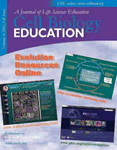WWW.Cell Biology Education: Evolution Web Sites
EVOLUTION WEB SITES
The debate over teaching evolution has once again reached a fever pitch in the United States. Earnest nineteenth-century clashes between scientific and religious worldviews have given way to the politically charged arguments of creation science and now intelligent design. The Web site of the National Center for Science Education (NCSE; www.natcenscied.org) is the online destination for keeping abreast of the cultural battles over teaching biological evolution. At NCSE, you will not find teaching resources per se, but information and ideas for keeping evolution alive in the curriculum. The site contains up-to-date information on legislation and school board activities nationwide. The site also specializes in debunking intelligent design arguments.
Figure 1. Ray Troll's interactive feature on human evolution. Printed by permission of Ray Troll.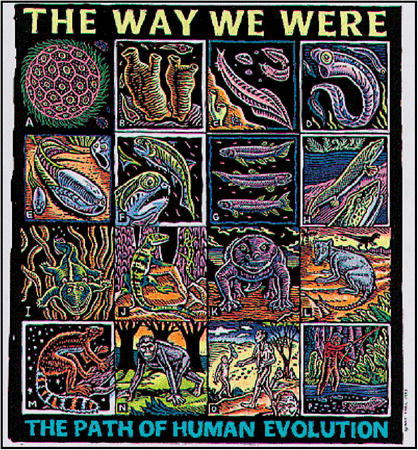
Figure 2. The welcoming screen of Understanding Evolution is organized into“ Teaching Evolution” and “Learning Evolution.” Printed by permission of Berkeley Museum of Paleontology.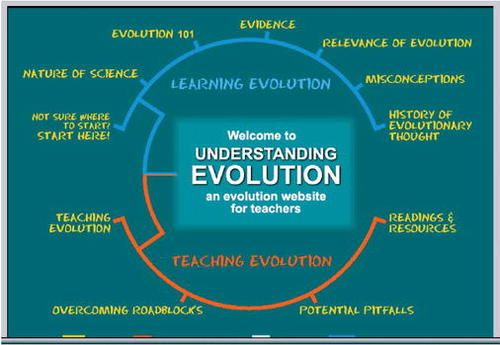
However, for those weary of the culture wars, it might be best to ease into the topic by first viewing an animation at Trollart.com ( www.trollart.com/evo.html) of how humans evolved from single-celled organisms (Figure 1). You will also find a 12-step program for evolving into a human, illustrated in the bold graphic style that embodies artist Ray Troll's slightly twisted love of nature. I will emphasize three Web sites in this review but include a longer list at the end. Most evolution Web sites include links to other useful sites as well.
UNIVERSITY OF CALIFORNIA-BERKELEY'S UNDERSTANDING EVOLUTION
http://evolution.berkeley.edu
The intrinsic challenge of teaching the topic sometimes gets lost in the cultural arguments about evolution. Controversy aside, evolution is challenging subject matter to teach well. Trolling the Web for resources to support evolution education requires sifting through virtual reams of unproductive and even toxic links, like David Duke's European-American page, found when searching “genes and evolution.” Fortunately, there are quality Web sites that support the teaching of evolution.
The Understanding Evolution Web site (Figures 2,3,4) is a scion of the University of California—Berkeley Museum of Paleontology ( www.ucmp.berkeley.edu/exhibit/exhibits.html). For years, the museum has been recognized as an excellent online source of information on evolution, geology, and phylogeny. For the purposes of supporting education in evolution, the Berkeley group wisely elected to produce a more self-contained Web site full of resources and teacher support features. The majority of the content is aimed at a high school level, but there is good support for adapting learning modules to lower grade levels. A sizable portion of the materials would translate well to the undergraduate level.
Materials on the Berkeley site are organized into optional teaching and learning paths. Under “Learning Evolution,” one can follow a linear path of Nature of Science. Evolution 101. Evidence. Relevance of Evolution. Misconceptions. History of Evolutionary Thought. Under each major topic are many subtopics and various interactive learning modules. For example, “What Did T. rex Taste Like?” introduces the concept of a common origin for all life and how the relationships among various groups of organisms can be organized. Understanding life's family tree can help answer comic but engaging questions, such as guessing the taste of a Tyrannosaurus rex T-bone, while driving home some profound biology. Different versions of the activity and ancillary materials support adoption at different educational levels.
Figure 3. Understanding Evolution features bold, colorful graphics and interactive features. Printed by permission of Berkeley Museum of Paleontology.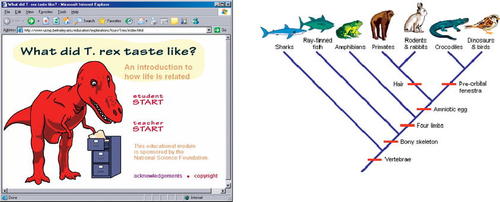
Figure 4. Understanding Evolution is part of the larger Berkeley Museum of Paleontology Web site that features photographs of fossils and other research materials. Printed by permission of Berkeley Museum of Paleontology.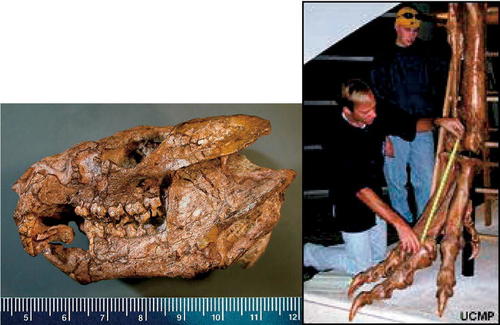
The Web site features bold, clear graphics, with concise text and engaging interactivity. While progressing through the materials, there are ample opportunities to take side paths or even major diversions into the larger museum Web site. Useful quizzes and tips to teachers are interspersed throughout, along with relevant additional resources, including outside links.
Web site contents are displayed along the page banner in a nested,“ bread crumb” fashion to aid navigation and orientation in the large Web site. For example, nested under “Lines of Evidence” is“ Evidence by Example,” and then further nested is“ Experiments.” John Endler's famous guppies are featured, as are his observations and experiments in the native ponds of Trinidad. There is a link from there to “Mechanisms of Microevolution,” highlighting Endler's artificial selection lab experiments on the same guppies.
Understanding Evolution benefits from its close ties to the larger museum Web site, because the hyperlinks facilitate moving from the engaging, cartoon style of Understanding Evolution to elements of the larger museum Web site more directly tied to the world of research science. For example, a large specimen collection with good photographic representation helps students move from cartoons to real fossils and other data.
PBS-WGBH BOSTON'S EVOLUTION
http://www.pbs.org/wgbh/evolution
Another large collection of evolution resources can be found on the Web pages of the Public Broadcasting Service (PBS) television network (Figure 5). Produced by Boston PBS affiliate WGBH, Evolution is companion to the TV series that first aired in 2001. Unlike most Web sites associated with a television broadcast, WGBH's site is truly a rich educational resource and includes materials that go well beyond simply supporting the viewing of the TV series. The Web site content stands on its own as a valuable resource independent of the series.
Figure 5. The WGBH Evolution Web site offers materials that complement and go beyond the PBS television series. Printed by permission of WGBH Boston.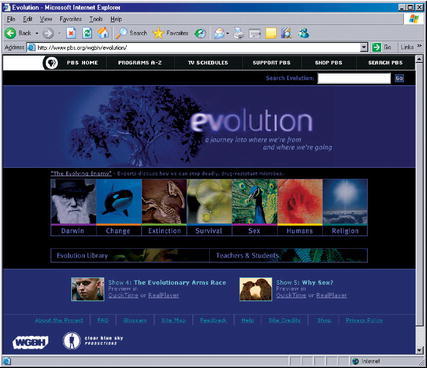
Figure 6. “Sex and the Single Guppy” lets a learner set the selective conditions for generating virtual guppy populations. Printed by permission of WGBH Boston.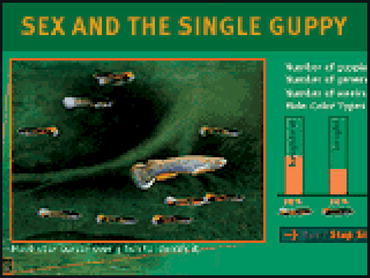
The WGBH Web site has rich graphics with some highly interactive features. For example, guppies are used to illustrate points about adaptation and natural selection (Figure 6). The guppy feature is very engaging, encouraging the learner to generate simulated guppy populations of varying composition, under different selective pressures, and to consider multiple hypotheses. I generated several virtual guppy populations. I first started with a population evenly divided between drab and colorful male guppies. I cut the simulation off after just four generations, and the population was fairly evenly distributed across a spectrum from drab to colorful male fish. I ran the same starting parameters again and this time went for lunch. After 64 generations (3,228 simulated weeks), I had 220 guppies in my pool, and they were now 100% maximally drab because of intense predatory pressure. For another experiment, I started with a population of drab males and weak predation pressure. I wandered down the hall for a meeting, and when I returned, 521 virtual weeks later, 15 generations had passed, and all the drab fish had been replaced with brilliant progeny. These virtual experiments could be useful student exercises and good supplements to wet-lab experiments.
Despite some engaging online learning modules, at first I found the Web site somewhat difficult and distracting to navigate. However, by shortcutting to the “library” section, most of the resources can be found topically arranged in a manner useful to an instructor. Many gems can be unearthed by browsing the Web site. For example, under “Evolution Revolution” (a social-intellectual timeline), I found the following quote: “It is indeed remarkable that this theory [evolution] has been progressively accepted by researchers, following a series of discoveries in various fields of knowledge. The convergence, neither sought nor fabricated, of the results of work that was conducted independently is in itself a significant argument in favour of this theory.” These words were written in 1996 by Pope John Paul II. One can also compare the results of Gallup polls across the decades, revealing surprisingly little change in American attitudes concerning evolution. Nearly half of those polled believe in special creation for humans, only a tenth believe human evolution followed completely natural mechanisms, and 35%-40% believe in god-guided evolution (1982-2001). There are also some well-chosen excerpts from Darwin's diary that are both enlightening and highly entertaining.
My path of exploration gives an indication of the breadth of the Web site:“ Evolution Home”. “Teachers and Students”.“ Evolution Library”. “Evolution of Diversity”.“ An Origin of Species” (fictitious birds). “Coral Reef Connections”. “All in the Family” (cladistics). “Is Intelligent Life Inevitable” (opinion poll). “Darwin” (including journal excerpts). “Evolution Revolution” (social-intellectual timeline). “Sex and the Single Guppy”.“ Origins of Humankind”. “Riddle of the Bones”. Throughout the pages are nice lists of subtopics, external links, and lists of related links within the Web site. The “Evolution Library” indexes the materials as follows: “What Is Science” (39 items), “The Age of Darwin” (71 items), “Adaptation and Natural Selection” (87 items), “History of Life” (101 items),“ Evolution of Diversity” (59 items), “Evidence for Evolution” (117 items), “Human Evolution” (78 items),“ Why Evolution Matters” (85 items), and a glossary.
TREE OF LIFE WEB PROJECT—A CONSORTIUM HOSTED BY THE UNIVERSITY OF ARIZONA LIBRARY
http://www.tolweb.org
Evolution is a topic nearly as multifaceted and diverse as... as life itself. Therefore, why not visit a Web site that features our magnificent tree of life? The Tree of Life Web Project (ToLweb) is an open consortium of sorts, hosted by the University of Arizona Library. Considering that ToLweb seeks to collect information for all life on earth, the site (Figure 7) benefits from superior organization and tools to help readers utilize pages contributed by experts from around the world. ToLweb features clever navigation that provides a lesson in its own right about how life is organized and related. At the home page, visitors are invited to browse, to learn about evolution and phylogeny, to contribute media, or to build a tree house. The tree house concept is particularly welcoming to nonexpert visitors. To encourage schoolteachers and students in particular to participate, there is a builder's guide and toolkit. The tree houses are meant to be annotated collections of resources on the Web site, not original contributions of data and resources. Contribution to ToLweb is carefully restricted to those with recognized scientific credentials. I recommend starting with a ToL learning tour, or the Root Page, which is called“ Life on Earth,” before you move out along branches and explore. The Root Pages are entry pages to organisms collected under higher-order taxonomic groups (e.g., domain and kingdom). Branch and leaf pages contain more detailed information on smaller groups (e.g., family and genus) as well as individual species. The Web site administrators have suggested good routes for exploration, and they feature weekly “learn about” sessions featuring particular groups. You can even download the entire tree structure in a static XML format (it is about 30 megabytes).
Figure 7. The welcoming page of the Tree of Life Web Project is elegant and invites exploration. Printed by permission of ToLweb.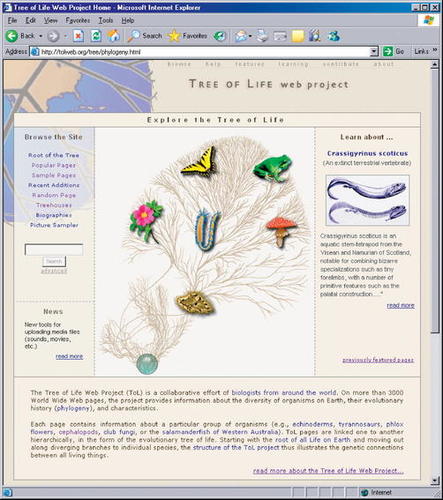
I started by searching about a personal favorite, octopus, and found 83 entries, including the taxonomic family Octopodidae. I found beautiful photos and great information, including how little is known about the complete diversity of what I think of as a highly visible group. Under“ Containing Groups” on the right-side navigation, I saw Octopodidae grouped under Octopoda, Octopodiformes, Mollusca, and of course Cephalopoda. I went to taxonomic class Cephalopoda and explored related animals. After learning about various cephalopods, I browsed the branches of family Octopodidae and eventually found the bizarre group represented by a single living species called the vampire squid, “a phylogenetic relict [that] possesses features of both octopods and decapods.” Multimedia features showed me how it swims and where in the world it lives.
The “random page” button accesses a Web page at random, and it's an interesting tool for making unexpected discoveries. Assigning a combination of directed exploration and random navigation might be useful for designing an assignment. The “random page” button could be used as a sampling method assessment. For example, students could be told to click the“ random page” button five times and draw the tree showing the relationship among the five randomly selected species.
The Web site is very much a work in progress, which again is a lesson about biodiversity on our planet and how inadequately cataloged and documented it is. I look forward to watching this site grow over the years. The site can accept movies, but so far there are very few. Someday I'd hope to see a tree house featuring movies of comparative locomotion among tetrapods, for example. I found ToLweb so rich and useful that I'm tempted to make it my browser home.
OTHER EVOLUTION WEBSITES
The World Wide Web is loaded with other excellent Web sites covering the topic of biological evolution, and many are linked to the pages of the Web sites reviewed above. Students, like most humans, tend to be most interested in themselves, and there are some excellent Web sites covering human evolution.
The DNAinteractive Web site, affiliated with Cold Spring Harbor Labs, has a very good section on Human Origins ( http://www.dnai.org/d/index.html?m=4).
Action BioScience ( http://www.actionbioscience.org/evolution) has excellent resources, primarily articles aimed at a college-level audience.
Howard Hughes Medical Institute's BioInteractive Web site ( http://www.hhmi.org/biointeractive) has an animation called “Evolution of the Y Chromosome” that charts the Y chromosome's many changes over its long history as a mammalian sex chromosome.
Human Evolution: The Fossil Evidence in 3D ( http://www.anth.ucsb.edu/projects/human/#) features three-dimensional models of primate skulls that can be rotated for comparison.
The Becoming Human Web site ( http://www.becominghuman.org) of the Institute of Human Origins features a documentary film and other resources.
The Human Origins Program ( http://www.mnh.si.edu/anthro/humanorigins/) of the Smithsonian Institution has an excellent collection of skulls that can be viewed online.
The Genographic Project ( http://www5.nationalgeographic.com/genographic/), recently launched by National Geographic, intends to analyze DNA from 100,000 people from all parts of the world to better understand the origins and migration patterns of modern humans. Visitors are encouraged to purchase a DNA test kit and participate.
FOOTNOTES
Comments on this review and suggestions of other valuable Web sites for learning about evolution are most welcome. Please send comments to Dennis Liu at [email protected] or, even better, visit the CBE discussion forum ( http://www.cellbioed.org/discussion/public/main.cfm) to share your comments with other readers of Cell Biology Education.


